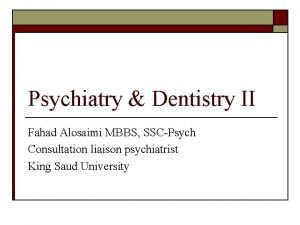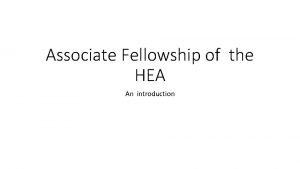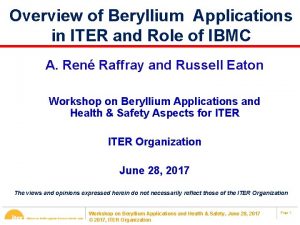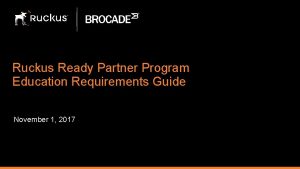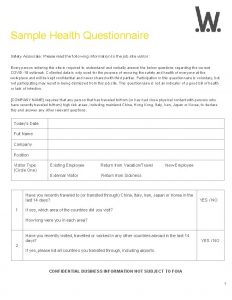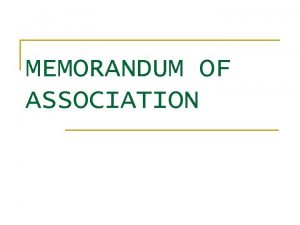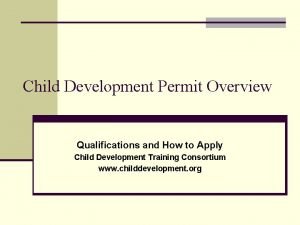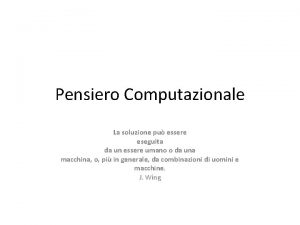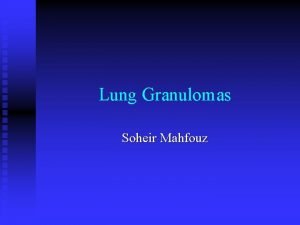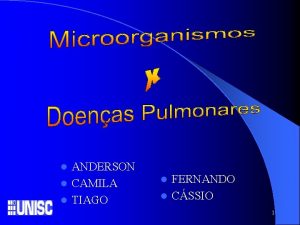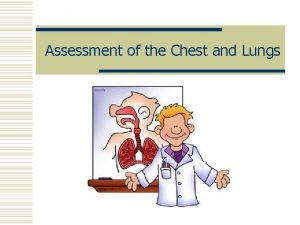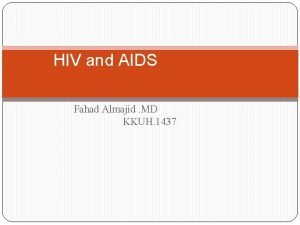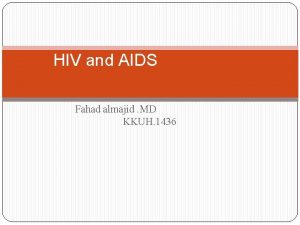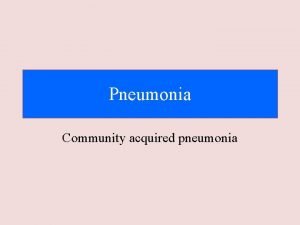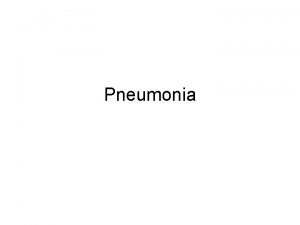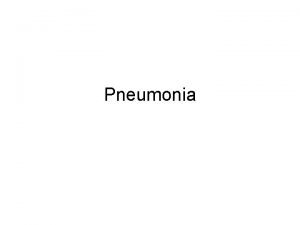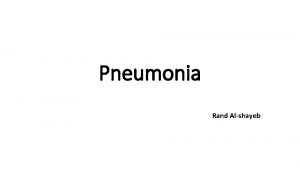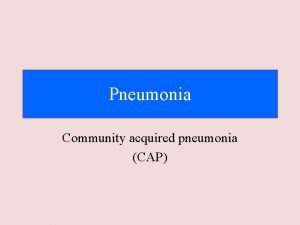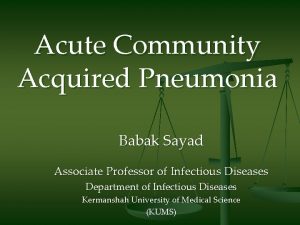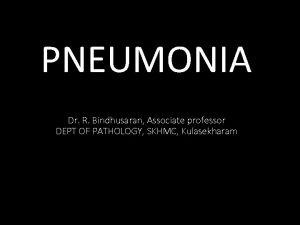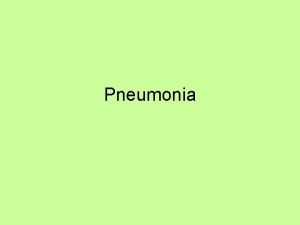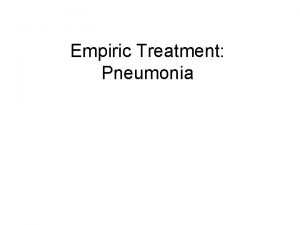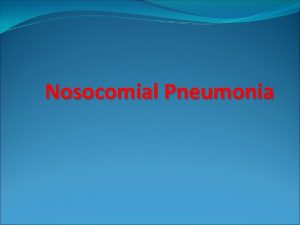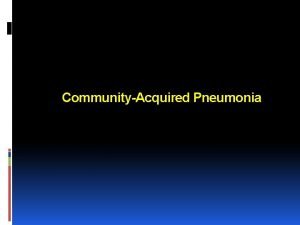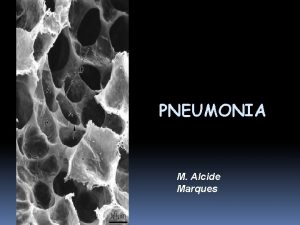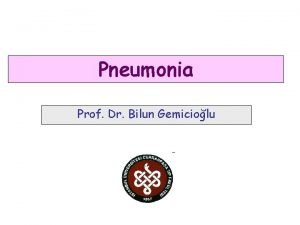Pneumonia Fahad M Almajid MD Associate Professor of












































- Slides: 44

Pneumonia Fahad M Almajid. MD Associate Professor of Infectious diseases 1436

What is Pneumonia? Pneumonia is an an acute infection of the pulmonary parenchyma. alveolar infection leading to consolidation of the greater part or one or more lobes, . resulting in alveolar filling with fluid causing Air space disease (consolidation and exudation). It is a common and potentially serious illness with considerable morbidity and mortality, particularly in : 1) Older adult patients. 2) Patients with significant comorbidities.

CLASSIFICATION Practical classification Community Acquired Pneumonia (CAP) Hospital Acquired Pneumonia (HAP) Ventilator Associated Pneumonia (VAP) Health Care Associate Pneumonia (HCAP) Aspiration Pneumonia in the Immunocompromised Patients

Pneumonia: Definitions Community Acquired Pneumonia (CAP) Infection is acquired in the community. Hospital Acquired Pneumonia (HAP) Pneumonia > 48 hours after admission which was not incubating at the time of admission. A) Ventilator Associated Pneumonia (VAP) pneumonia > 48 hours after intubation. B) Health Care Associate Pneumonia (HCAP)

Health Care Associate Pneumonia (HCAP) Pneumonia that occurs in a nonhospitalized patient with extensive healthcare contact: Intravenous therapy, wound care, or intravenous chemotherapy within the prior 30 days Residence in a nursing home or other long-term care facility Hospitalization in an acute care hospital for two or more days within the prior 90 days Attendance at a hospital or hemodialysis clinic within the prior 30 days

Pathogenesis 1) Inhalation, 2) aspiration and 3) hematogenous spread Primary inhalation: Organisms bypass normal respiratory defense mechanisms or when the Pt inhales aerobic GN organisms that colonize the upper respiratory tract or respiratory support equipment

Pathogenesis Aspiration: when the Pt aspirates colonized upper respiratory tract secretions Stomach: reservoir of GNR that can ascend, colonizing the respiratory tract. Hematogenous: Originate from a distant source and reach the lungs via the blood stream.

Pathogenesis Microaspiration from nasopharynx: S. Pneumonia Inhalation: S. Pneumonia , TB, viruses, Legionella Aspiration: anaerobes Bloodborne: Staph endocarditis, septic emboli

Community acquired pneumonia Pathogens Ø Usually caused by a single organism. Ø S. pneumoniae is the most common cause of communityacquired pneumonia (CAP), Ø isolation of the organism in only 5 to 18 percent of cases. Ø Many culture-negative cases are caused by pneumococcus: 1) sputum culture is negative in about 50 percent of patients with concurrent pneumococcal bacteremia. 2) majority of cases of unknown etiology respond to treatment with penicillin Ø Caused by a variety of Bacteria, Viruses, Fungi

Pneumococci are acquired by aerosol inhalation, leading to colonization of the nasopharynx. Colonization is present in 40 -50 percent of healthy adults and persists for four to 6 weeks. (carriage is more common in children and smokers )

Risk factors Influenza infection Alcohol abuse Smoking Hyposplenism or splenectomy Immunocompromise due to : a) Multiple myeloma b) Systemic lupus erythematosus c) Transplant recipients

Aspiration Pneumonia Common pathogens Mixed flora Mouth anaerobes Peptostreptococcus spp, Actinomyces spp. Stomach contents Chemical pneumonitis Enterobacterium

TYPICAL Clinical presentation Symptomes: Sudden onset Fever with chills. Productive cough, Mucopurulent sputum Pleuritic chest pain Signs: Breath sound: Auscultatory findings of rales and bronchial breath sounds are localized to the involved segment or lobe.

Consolidation is signs: Dullness on percussion. § Bronchial breath sounds. § Egophony § Whispered pectoriloquy (whispers, are § transmitted clearly ). §

Pneumococcal pneumonia may present atypically, especially in older adults where confusion or delirium may be an initial manifestation.

Atypical pneumonia: Clinical presentation Atypical Gradual onset Afebrile Dry cough Breath sound: Rales Uni/bilateral patchy, infiltrates WBC: usual normal or slight high Sore throat, myalgia, fatigue, diarrhea Common etiology Mycoplasma pneumoniae Chlamydia pneumoniae Legionella pneumophilla Mycobactria Virus

Investigations CXR : CBC with diff. Sputum gram stain, culture susceptibility Blood Culture ABG Urea / Electrolytes

DIAGNOSIS Chest x ray: Demonstre infiltrate. Establish Dx To detect the presence of complications such as : pleural effusion (Parapneumonic effusion). multilobar diseaseas

32 Y/O male Cough for 1 wk Fever for 2 days Rales over LLL


Pneumonia Diagnosis Sputum gram stain and culture Good specimen PMN’s>25/LPF Few epithelial cells<10/LPF Single predominant organism

Pneumonia Common organisms Gram positive: diplococci (pairs and chains) Gram positive: clusters, ie staphylococcal pneumonia Gram negative: coccobacillary, ie K. P. Gram negative: rods Gram stain Organisms not visible on gram stain M. pneumonia, Chlamydia Legionella pneumophila Viruses Mycobacterium

Empiric outpt Management in Previously Healthy Pt No comorbidities, no recent antibiotic use, and low rate of resistance: Azithromycin – 500 mg on day one followed by four days of 250 mg a day or 500 mg daily for three days Clarithromycin – 500 mg twice daily for five days Doxycycline – 100 mg twice daily IDSA/ATS Guidelines 2007

/ Comorbidities, recent antibiotic use, or high rate of resistance: A respiratory fluoroquinolone : levofloxacin 750 mg daily, or moxifloxacin 400 mg daily, or gemifloxacin 320 mg daily for five days …. OR

Combination therapy : a beta-lactam AND macrolide. amoxicillin, 1 g three times daily or amoxicillin-clavulanate 2 g twice daily cefuroxime 500 mg twice daily. Pathogen-directed therapy

Empiric Inpt Management-Medical Ward Organisms: all of the above plus polymicrobial infections (+/- anaerobes), Legionella Recommended Parenteral Abx: Respiratory fluoroquinolone, OR Advanced macrolide plus a beta-lactam Recent Abx: As above. Regimen selected will depend on nature of recent antibiotic therapy. IDSA/ATS Guidelines 2007

Complications of Pneumonia Bacteremia Respiratory and circulatory failure Pleural effusion (Parapneumonic effusion), empyema, and abscess Pleural fluid always needs analysis in setting of pneumonia (do a thoracocentisis) needs drainage if empyema develop: Chest tube, surgical

Streptococcus pneumonia Most common cause of CAP Gram positive diplococci Symptoms : malaise, shaking chills, fever, rusty sputum, pleuritic chest pain, cough Lobar infiltrate on CXR 25% bacteremic

Risk factors for S. pneumonia Splenectomy (Asplenia) Sickle cell disease, hematologic diseases Smoking Bronchial Asthma and COPD HIV ETOH

S. Pneumonia Prevention Pneumococcal conjugate vaccine (PCV) is a vaccine used to protect infants and young children 7 serotypes of Streptococcus Pneumococcal polysaccharide vaccine (PPSV) 23 serotypes of Streptococcus PPSV is recommended (routine vaccination) for those over the age of 65

VACCINATION For both children and adults in special risk categories: Serious pulmonary problems, eg. Asthma, COPD Serious cardiac conditions, eg. , CHF Severe Renal problems Long term liver disease DM requiring medication Immunosuppression due to disease (e. g. HIV or SLE) or treatment (e. g. chemotherapy or radio therapy, longterm steroid use Asplenia

Haemophilus influenzae Nonmotile, Gram negative rod Secondary infection on top of Viral disease, immunosuppression, splecnectomy patients Encapsulated type b (Hib) The capsule allows them to resist phagocytosis and complement-mediated lysis in the nonimmune host Hib conjugate vaccine

Specific Treatment Guided by susceptibility testing when available S. pneumonia: β-lactams Cephalosporins, eg Ceftriaxone, Penicillin G Macrolides eg. Azithromycin Fluoroquinolone (FQ) eg. levofluxacin Highly Penicillin Resistant: Vancomycin H. influenzae: Ceftriaxone, Amoxocillin/Clavulinic Acid (Augmentin), FQ, TMP-SMX

CAP: Atypicals Mycoplasma pneumoniae, Chlamydophila pneumoniae, Legionella; Coxiella burnetii (Q fever), Francisella tularensis (tularemia), Chlamydia psittaci (psittacosis) Approximately 15% of all CAP ‘Atypical’: not detectable on gram stain; won’t grow on standard media

ATYPICAL Unlike bacterial CAP, often extrapulmonary manifestations: Mycoplasma: otitis, nonexudative pharyngitis, watery diarrhea, erythema multiforme, increased cold agglutinin titre Chlamydophila: laryngitis Most don’t have a bacterial cell wall Don’t respond to βlactams Therapy: macrolides, tetracyclines, quinolones (intracellular penetration, interfere with bacterial protein synthesis)

Remember these associations: Asplenia: Strep pneumo, H. influ Alcoholism: Strep pneumo, oral anaerobes, K. pneumo, Acinetobacter, MTB COPD/smoking: H. influenzae, Pseudomonas, Legionella, Strep pneumo, Moraxella catarrhalis, Chlamydophila pneumoniae Aspiration: Klebsiella, E. Coli, oral anaerobes

HIV: S. pneumo, H. influ, P. aeruginosa, MTB, PCP, Crypto, Histo, Aspergillus, atypical mycobacteria Recent hotel, cruise ship: Legionella Structural lung disease (bronchiectasis): Pseudomonas, Burkholderia cepacia, Staph aureus ICU, Ventilation: Pseudomonas, Acinetobacter

Pneumonia: Outpatient or Inpatient? CURB-65 5 indicators of increased mortality: confusion, BUN >7, RR >30, SBP <90 or DBP <60, age >65 Mortality: 2 factors 9%, 3 factors 15%, 5 factors 57% Score 0 -1 outpt. Score 2 inpt. Score >3 ICU. Pneumonia Severity Index (PSI) 20 variables including underlying diseases; stratifies pts into 5 classes based on mortality risk No RCTs comparing CURB-65 and PSI IDSA/ATS Guidelines 2007

Pneumonia: Medical floor or ICU? 1 major or 3 minor criteria= severe CAP ICU Major criteria: Invasive ventilation, septic shock on pressors Minor criteria: RR>30; multilobar infiltrates; confusion; BUN >20; WBC <4, 000; Platelets <100, 000; Temp <36, hypotension requiring aggressive fluids, Pa. O 2/Fi. O 2 <250. No prospective validation of these criteria IDSA/ATS Guidelines 2007

CAP Inpatient therapy General medical floor: Respiratory quinolone OR IV β-lactam PLUS macrolide (IV or PO) β-lactams: cefotaxime, ceftriaxone, ampicillin; ertapenem May substitute doxycycline for macrolide (level 3) ICU: β-lactam (ceftriaxone, cefotaxime, Amox-clav) PLUS EITHER quinolone OR azithro PCN-allergic: respiratory quinolone PLUS aztreonam Pseudomonal coverage : Antipneumococcal, antipseudomonal β-lactam (pip-tazo, cefepime, imi, mero) PLUS EITHER (cipro or levo) OR (aminoglycoside AND Azithro) OR (aminoglycoside AND respiratory quinolone) CA-MRSA coverage: Vancomycin or Linezolid

CAP Inpatient Therapy: Pearls Give 1 st dose Antibiotics in ER (no specified time frame) Switch from IV to oral when pts are hemodynamically stable and clinically improving Discharge from hospital: As soon as clinically stable, off oxygen therapy, no active medical problems Duration of therapy is usually 7 -10 days: Treat for a minimum of 5 days Before stopping therapy: afebrile for 48 -72 hours, hemodynamically stable, RR <24, O 2 sat >90%, normal mental status Treat longer if initial therapy wasn’t active against identified pathogen; or if complications (lung abscess, empyema)

CAP: Influenza More common cause in children RSV, influenza, parainfluenza Influenza most important viral cause in adults, especially during winter months Inhale small aerosolized particles from coughing, sneezing 1 -4 day incubation ‘uncomplicated influenza’ (fever, myalgia, malaise, rhinitis) Pneumonia Adults > 65 account for 63% of annual influenzaassociated hospitalizations and 85% of influenza-related deaths.

CAP: Influenza Recent worlwide pandemic of H 1 N 1 Influenza A (20092010) Current epidemic in Saudi Arabia (2010 -2011) H 1 N 1 risk factors pregnant, obesity, cardipulmonary disease, chronic renal disease, chronic liver disease CXR findings often subtle, to full blown ARDS Respiratory (or Droplet) isolation for suspected or documented influenza (Wear mask and gloves) NP swab for, Rapid Ag test Influ A, B. H 1 N 1 PCR RNA Current Seasonal Influenza Vaccine prevents disease (given every season) Bacterial pnemonia (S. pneumo, S. aureus) may follow viral pneumonia

Influenza: Therapy Neuraminidase inhibitors Adamantanes Oseltamivir / Tamiflu 75 mg po bid Zanamivir / Relenza 10 mg (2 inhalations) BID Amantadine / Symmetrel 100 mg po bid Rimantadine / Flumadine 100 mg po qd Influenza A, B Influenza A H 1 N 1 resistant to Adamantanes Neuraminidase inhibitors: 70 -90% effective for prophylaxis Give within 48 h of symptom onset to reduce duration/severity of illness, and viral shedding Osteltamivir dose in severe disease 150 mg bid
 Promotion from associate professor to professor
Promotion from associate professor to professor Neurosis vs psychosis
Neurosis vs psychosis Fahad subhi mohammed
Fahad subhi mohammed Sales profit chain
Sales profit chain Direct cache mapping
Direct cache mapping Hea associate fellowship
Hea associate fellowship Critical thinking is an active process of discovery
Critical thinking is an active process of discovery Mhp associate partner gehalt
Mhp associate partner gehalt Physician associate lecturer
Physician associate lecturer Cincinnati state associate degrees
Cincinnati state associate degrees Inca civilization
Inca civilization Iter project associate
Iter project associate Cipd assessment examples
Cipd assessment examples Imeche associate membership
Imeche associate membership Cern pjas
Cern pjas Associate consultant in capgemini
Associate consultant in capgemini Delta chi associate member pin
Delta chi associate member pin Rcog associate
Rcog associate Ruckus certified networking associate
Ruckus certified networking associate Lone star college nursing program cost
Lone star college nursing program cost Safety associate
Safety associate Critical aad
Critical aad Name something you associate with superman
Name something you associate with superman To associate
To associate Associate's degree in the netherlands
Associate's degree in the netherlands Associate program
Associate program Associate degree rmit
Associate degree rmit Mbcs membership
Mbcs membership Analyst hierarchy
Analyst hierarchy Rekenhulp tegemoetkoming scholieren
Rekenhulp tegemoetkoming scholieren Memorandum meaning
Memorandum meaning Sep certification
Sep certification Associate warden
Associate warden Los angeles harbor college catalog
Los angeles harbor college catalog Child development matrix
Child development matrix Associate consulting engineers
Associate consulting engineers Associate consultant in capgemini
Associate consultant in capgemini Cumsa certificate
Cumsa certificate Tecniche associate al pensiero computazionale
Tecniche associate al pensiero computazionale Harper college international students
Harper college international students Marine corps league uniforms
Marine corps league uniforms Post primary tb
Post primary tb Pneumonia tipica e atipica
Pneumonia tipica e atipica Anatomical classification of pneumonia
Anatomical classification of pneumonia What is tactile fremitus
What is tactile fremitus

